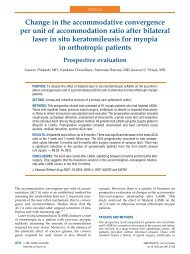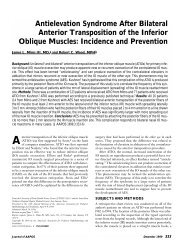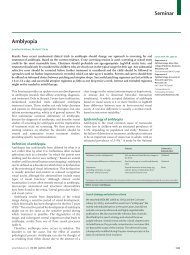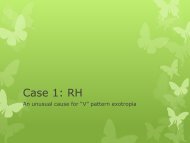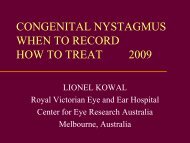What's new AAPOS 2008 - The Private Eye Clinic
What's new AAPOS 2008 - The Private Eye Clinic
What's new AAPOS 2008 - The Private Eye Clinic
You also want an ePaper? Increase the reach of your titles
YUMPU automatically turns print PDFs into web optimized ePapers that Google loves.
GLAUCOMA<br />
Surgical outcome of primary developmental glaucoma: a single surgeon's longterm<br />
experience from a tertiary eye care centre in India.<br />
Mandal AK, Gothwal VK, Nutheti R.<br />
<strong>Eye</strong>. 2007 Jun;21(6):764-74<br />
Six hundred and twenty-four eyes of 360 consecutive patients who underwent primary<br />
combined trabeculotomy-trabeculectomy (CTT) for PDG from January 1990 to June<br />
2004 were studied. <strong>The</strong> main outcome measures were pre- and postoperative<br />
intraocular pressures (IOPs), corneal clarity, visual acuities, refractive errors, success<br />
rate, time of surgical failure, complications, and factors associated with poor outcome.<br />
IOP reduced from 28.1+/-7.5 to 14.9+/-5.9 mmHg (P35 mmHg and two-fold in cases with a history of prior glaucoma<br />
surgery. <strong>The</strong>re were no major intraoperative complications, bleb-related infection, or<br />
endophthalmitis.<br />
<strong>The</strong> effects of sevoflurane and ketamine on intraocular pressure in children<br />
during examination under anesthesia.<br />
Blumberg D, Congdon N, Jampel H, Gilbert D, Elliott R, Rivers R, Munoz B, Quigley H.<br />
Am J Ophthalmol. 2007 Mar;143(3):494-9. Epub 2007 Jan 2.<br />
PURPOSE: We studied the effects on intraocular pressure (IOP) of anesthesia<br />
administered during examination under anesthesia (EUA) in children.<br />
METHODS: This randomized trial compared IOP after inhaled sevoflurane gas to that<br />
after intramuscular ketamine hydrochloride in children undergoing EUA. IOP was<br />
measured in 30 eyes with TonoPen XL (Mentor, Inc, Norwell, Massachusetts, USA) as<br />
soon as possible after anesthesia induction (T1) and two, four, six, and eight minutes<br />
thereafter. At the same times, we recorded systolic and diastolic blood pressure (SBP,<br />
DBP) and heart rate (HR).<br />
RESULTS: Compared with the mean IOP at T1, IOP in the sevoflurane group was<br />
significantly lower for all measurements from two to eight minutes thereafter (mean<br />
decrease in IOP: two minutes = 12%, four minutes = 19%; six minutes = 19%; eight<br />
minutes = 17%, all P < or = .01). In the ketamine group, mean IOP was not significantly<br />
changed from T1 through six minutes, whereas at eight minutes, it was 7% lower (P =<br />
92



